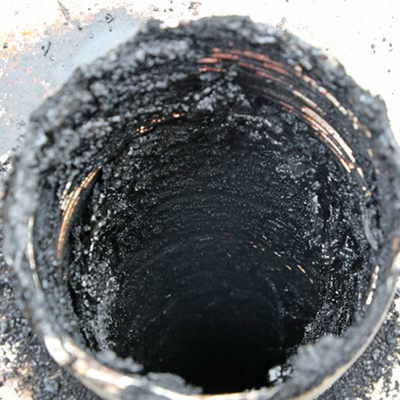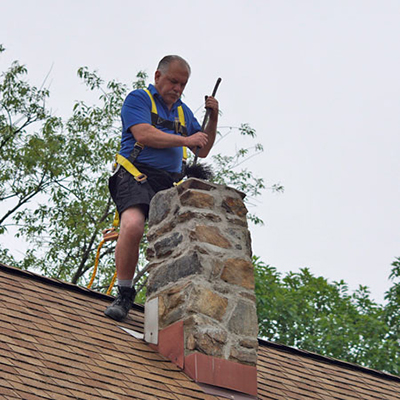Prevent Creosote Buildup with The Help of Professionals
 Ugly soot stains aren’t all that builds up in chimneys. Creosote is another byproduct that’s produced by burning wood logs, pellets and coal in a fireplace or stove. Creosote is an extremely flammable chemical compound that condenses along the walls of chimneys and venting systems. It is the leading cause of catastrophic chimney fires according to the National Fire Protection Association. Unfortunately, there is no way to stop creosote from accumulating in your home’s chimney, but it is possible to reduce creosote buildup and prevent it from causing a fire with the help of professionals.
Ugly soot stains aren’t all that builds up in chimneys. Creosote is another byproduct that’s produced by burning wood logs, pellets and coal in a fireplace or stove. Creosote is an extremely flammable chemical compound that condenses along the walls of chimneys and venting systems. It is the leading cause of catastrophic chimney fires according to the National Fire Protection Association. Unfortunately, there is no way to stop creosote from accumulating in your home’s chimney, but it is possible to reduce creosote buildup and prevent it from causing a fire with the help of professionals.
Why Worry About a Chimney Fire?
You might be wondering what the big deal is about chimney fires if the flames stay in the chimney instead of spreading to your home. Even though chimneys are designed to withstand high temperatures, a fire in your chimney can still cause severe damage from a cracked chimney liner to a chimney collapse to a house fire. According to the latest research, chimney fires cause an average of $1.5 million in property damages every year in the United States. House fires that originate in a chimney are responsible for hundreds of injuries and deaths annually. Chimney fires caused by creosote are especially dangerous because this flammable compound can burn for hours at extremely high temperatures resulting in greater risk to your home and health.
How to Reduce Creosote Buildup
You can reduce the risk of a chimney fire this winter by following these best practices to decrease creosote buildup.
1. Hire a CSIA certified chimney sweep to remove creosote from the last burning season.
Both the National Fire Protection Agency and Chimney Safety Institute of America (CSIA) recommend having your chimney cleaned by a professional chimney sweep at least once a year. It is one of the most important preventative measures that you can take to reduce the risk of a chimney fire. Even a small amount of creosote, if ignited, can result in a powerful chimney fire. Removing creosote on your own without professional training and equipment can be both dangerous and ineffective. Even if you only used your fireplace a few times last season, it is smart to call on a certified chimney sweep to clean your chimney before you use it again this winter.
2. Warm up the flue before starting a fire in the fireplace.
Every time you use your fireplace, you can reduce the amount of creosote that will build up in it by warming up the flue first. When the flue or inside of the chimney is cold, the fire will burn less efficiently, and more condensation will buildup in your chimney which means larger creosote deposits. The best way to heat up the flue is to roll up a few sheets of paper or newspaper, light it, and hold it up in your fireplace right under the damper or mouth of the chimney. You should be able to feel the air in the chimney warm up. You may also notice that the draft reverses (instead of feeling cold air coming down the chimney, you’ll notice the heat from your torch going up the chimney).
3. Only burn hard, seasoned firewood. Do not use artificial logs.
When you build a fire, avoid using firewood that is wet or unseasoned instead use dry, seasoned firewood. Wood needs at least six months to season or dry out enough to burn efficiently. Firewood that has a high moisture content, like unseasoned wood, will produce more smoke and, therefore, extra creosote. Softwoods like cedar and pine also burn less efficiently than hardwoods like oak, maple, hickory, and cherry.
Though artificial logs often claim to produce less creosote than natural logs, this is rarely true. Usually, burning artificial logs produces more combustion gases which results in larger amounts of creosote. Opt for natural wood instead.
4. Build efficient fires that burn hot instead of smoldering, slow-burning fires.
You might have noticed that efficiency plays a key role in reducing creosote buildup. The hotter your fire burns and the less smoke it produces, the cleaner your chimney will be. How you build a fire impacts its efficiency almost as much as the wood that you use. Arranging the firewood in your fireplace so that there is enough space between the logs for good airflow is the best way to build an efficient, cleaner burning fire. Be sure not to overload the fire with too many logs which can cut down on airflow or cause the fire to get out of control. A couple of seasoned logs stacked on top of kindling is all you need for a hot, efficient fire. Keeping the fireplace doors open will also improve airflow.
 Following these 4 simple guidelines will help keep you and your home safe this winter. If you haven’t taken the first step to prevent a chimney fire, give us a call to setup an annual chimney cleaning! All of the chimney sweeps on our team at Hudson Valley Chimney Service are CSIA certified to perform thorough chimney cleanings and chimney inspections. We have been serving residents in New York’s Hudson Valley since 1976.
Following these 4 simple guidelines will help keep you and your home safe this winter. If you haven’t taken the first step to prevent a chimney fire, give us a call to setup an annual chimney cleaning! All of the chimney sweeps on our team at Hudson Valley Chimney Service are CSIA certified to perform thorough chimney cleanings and chimney inspections. We have been serving residents in New York’s Hudson Valley since 1976.








